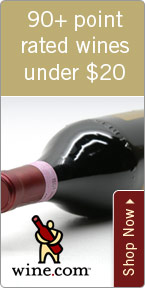A Worrisome Time For Wine Lovers

Wednesday - September 16, 2009
| Share
 Del.icio.us
Del.icio.us
|
I am worried. There are some things amiss in the wine world and they have me thinking of disastrous effects. The world will not end, mind you. But a few things have made more than wonder.
I recently found out that screw caps are not the knights in shining armor that many have proposed. I have always said that what is inside the bottle is more important than what closure it uses. And that is exactly what has me worried. The major problem for screw caps (other than people thinking it makes the wine cheap) is that it causes reduction in the wine. Reduction in wine terms means that usually an aromatic molecule loses an oxygen molecule, thereby “reducing” its oxidation number and relegating the once-aromatic compound to something non-aromatic.
In other words, reduction dumbs down a wine’s aroma and mutes its flavor. Many winemakers are now aware of this effect on wine by screw-capped bottles. There is one way around it: by adding copper sulphate. I found out recently from Paul White’s column in Decanter Magazine (my favorite periodical) that the European Union allows only 1ppm (parts per million), and the United States’threshold is even lower at 0.5ppm as its production standards.
But Australia and New Zealand food safety authorities have done away with any legal limits for residual copper in wine. White cites a case where a German importer rejected 4,000 cases of New Zealand-produced Te-Kairanga 2006 Pinot Noir for excess copper sulphate levels at 2.6ppm!
I don’t know about you,
but I surely do not want the additional copper in my diet. Isn’t it strange that this additive is not listed on the bottles of New Zealand and Australian screw-capped wines? Is that much copper sulphate safe to consume, or am I just paranoid?
Another thing that has me worried is the state of Bordeaux these days. It is just so expensive. The top Chateaux are now truly rarefied air. It seems that only the wealthy and celebrities can drink the top drops of Bordeaux: 2005 and 2006 were some of the most expensive wines to ever be released, 2007 was almost the same as 2006, and it was a worse vintage. And 2008 is certainly a better vintage, and the prices finally came back to within Earth’s orbit, for a little while anyway.
Chateau Lafite Rothschild’s first offering to the market was around $200/bottle in April. The top performers are now fetching more than $400/bottle including Chateau Lafite. I don’t know too many people who go out to dinner and drop almost $1,000 (including the restaurant’s markup) for a bottle of 2005 or 2006 Bordeaux. It’s as if these wines are now only commodities and showpieces. They certainly are not consumed on a regular basis. Because they are no longer affordable, I predict that fewer retailers and restaurants will stock them. Thus the Bordeaux market will fade in its importance to the majority of the wine world. This won’t happen overnight, but what incentive do people who enjoy great bottles of wine from around the world have when they must pay four to 20 times the price for a bottle of great Bordeaux when they can spend $50 to $100 on something terrific?
Yes, Bordeaux can make some truly haunting wines. But for most of us, Bordeaux’s top wines will always be out of our grasp.
Recommendations: 2007 Melville Estate Pinot Noir ($25) 2007 may well go down as one of the greatest vintages for Pinot Noir in California, and this one has just tons of flavor and sexy, sweet berry aromas. 2007 Sterling Vineyards Organic Chardonnay ($22) Yes, it’s organic, and yes it’s good, so good that I would recommend it for any “organic” or “whole food” store and restaurant. It has lip-smacking fruit and nice balance - a very nice combination.
Roberto Viernes is a master sommelier. E-mail .(JavaScript must be enabled to view this email address)E-mail this story | Print this page | Comments (0) | Archive | RSS Comments (0) |
Most Recent Comment(s):












